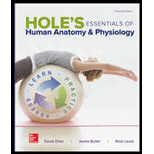
Concept explainers
Introduction: The body of humans is made of several important organ systems. It includes the digestive, circulatory, respiratory, nervous, excretory, and endocrine systems. All the systems function together to maintain the functioning of the body of the human.
Answer to Problem 1CA
Correct answer: d. all of the above.
Explanation of Solution
Reason for the correct answer:
The cardiovascular system is an organ system that allows blood to circulate and transport nutrients, carbon dioxide, oxygen, and blood cells, hormones to and from the cells present in the body. The cardiovascular system is also called a vascular system and it includes heart, blood, and blood vessels such as arteries, veins, and capillaries.
Option d. is given as “all of the above”.
Hence, the correct answer is option d.
Reasons for incorrect answers:
Option a. is given as “the heart”.
The cardiovascular system not only includes the heart. It also includes arteries, veins, and capillaries. Therefore, option a. is incorrect.
Option b. is given as “the arteries and veins”.
The cardiovascular system not only includes arteries and veins. It also includes the heart and capillaries. Therefore, option c. is incorrect.
Option c. is given as “the capillaries”.
The cardiovascular system not only includes capillaries, but it also includes heart, arteries, and veins. Therefore, option d. is incorrect.
Hence, options a., b., and c. are incorrect.
The cardiovascular system includes heart, arteries, veins, and capillaries.
Want to see more full solutions like this?
Chapter 13 Solutions
Hole's Essentials of Human Anatomy & Physiology
 Human Anatomy & Physiology (11th Edition)BiologyISBN:9780134580999Author:Elaine N. Marieb, Katja N. HoehnPublisher:PEARSON
Human Anatomy & Physiology (11th Edition)BiologyISBN:9780134580999Author:Elaine N. Marieb, Katja N. HoehnPublisher:PEARSON Biology 2eBiologyISBN:9781947172517Author:Matthew Douglas, Jung Choi, Mary Ann ClarkPublisher:OpenStax
Biology 2eBiologyISBN:9781947172517Author:Matthew Douglas, Jung Choi, Mary Ann ClarkPublisher:OpenStax Anatomy & PhysiologyBiologyISBN:9781259398629Author:McKinley, Michael P., O'loughlin, Valerie Dean, Bidle, Theresa StouterPublisher:Mcgraw Hill Education,
Anatomy & PhysiologyBiologyISBN:9781259398629Author:McKinley, Michael P., O'loughlin, Valerie Dean, Bidle, Theresa StouterPublisher:Mcgraw Hill Education, Molecular Biology of the Cell (Sixth Edition)BiologyISBN:9780815344322Author:Bruce Alberts, Alexander D. Johnson, Julian Lewis, David Morgan, Martin Raff, Keith Roberts, Peter WalterPublisher:W. W. Norton & Company
Molecular Biology of the Cell (Sixth Edition)BiologyISBN:9780815344322Author:Bruce Alberts, Alexander D. Johnson, Julian Lewis, David Morgan, Martin Raff, Keith Roberts, Peter WalterPublisher:W. W. Norton & Company Laboratory Manual For Human Anatomy & PhysiologyBiologyISBN:9781260159363Author:Martin, Terry R., Prentice-craver, CynthiaPublisher:McGraw-Hill Publishing Co.
Laboratory Manual For Human Anatomy & PhysiologyBiologyISBN:9781260159363Author:Martin, Terry R., Prentice-craver, CynthiaPublisher:McGraw-Hill Publishing Co. Inquiry Into Life (16th Edition)BiologyISBN:9781260231700Author:Sylvia S. Mader, Michael WindelspechtPublisher:McGraw Hill Education
Inquiry Into Life (16th Edition)BiologyISBN:9781260231700Author:Sylvia S. Mader, Michael WindelspechtPublisher:McGraw Hill Education





